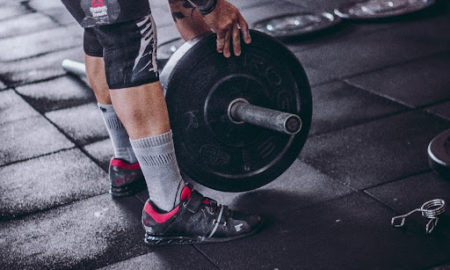Muscle contractions come in two basic flavors: eccentric, also known as negative, and concentric, or positive. Eccentric muscle contractions involve an active lengthening of muscle fibers, which usually means the lowering of a weight, such as when you descend to a full squat. Concentric muscle contractions feature a shortening of muscle fibers, as typically occurs during the raising of a weight—as when you drive up from a squat to a standing position.
Those aren’t the only types of muscle contractions. Isometric contractions are strong but achieved without any movement. Isokinetic contractions focus only on the positive portion of an exercise, with no eccentric component. As you might expect, bodybuilding exercises involve mainly eccentric and concentric contractions.
An ongoing debate among exercise scientists is whether one type of muscle contraction is superior. One man who took a definite stand on that issue was Arthur Jones, an eccentric genius best known for developing the Nautilus and MedX exercise machines, as well as the Nautilus high-intensity philosophy. He was a firm believer in the superiority of eccentric contractions for triggering gains in muscular size and strength. He repeatedly wrote of the importance of taking two seconds to raise a weight and four seconds to lower it, putting the emphasis on the negative portion of the rep. Jones eventually espoused a negative-only style of training for maximizing strength gains. His later exercise machines were designed to enable a user to accentuate the negative.
While it would seem that raising a weight is more intense than lowering it, numerous published studies show that most of the muscle damage incurred during training comes by way of the eccentric contractions. Apparently, lowering a heavy weight produces more damage to muscle fibers than raising it. As such, negative contraction is considered largely responsible for delayed-onset muscle soreness, or DOMS, a deep muscle soreness that peaks one to two days after you train a muscle intensely with exercises that have an eccentric component.
The advantage of eccentric contraction in this regard is that the extensive fiber damage it causes results in a compensation effect—the body responds by upgrading muscle protein production. The damaged muscle fiber is not only repaired but also thickened to accommodate the increased stress that was placed on it. The thickened fiber is recognizable as muscle hypertrophy, or growth, and it’s usually accompanied by an increase in strength.
The process takes some time, particularly after a workout that emphasizes negative work. Studies show that it takes a minimum of 48 hours to repair completely the damage wrought by eccentric contractions and for larger muscles, such as the thighs, it can take as long as 72 hours. If the muscle is trained before it’s fully repaired, the potential gains can be lost, a scenario that falls under the general heading of overtraining.
Some trainees take the repair process to questionable lengths. An example are those who suggest that the body can take up to two to three weeks to recover from high-intensity training marked by extensive muscle damage. The evidence for that is more apparent in long-distance endurance activity, such as marathon running, than in weight training. In some cases the muscle damage incurred during a 26-mile marathon can take as long as six months to be restored.
While all the evidence seems to point to eccentric contractions as being the most vital type of muscle contraction for stimulating gains in size and strength, not all studies have shown that. Some suggest the opposite—that positive contractions are superior—which tends to confuse the issue. A recent meta-analysis published in a leading sportsmedicine journal looked back at the research to find some clarity. Twenty prior studies that compared eccentric and concentric contractions were examined.
The researchers noted that muscles are capable of exerting greater absolute force during eccentric contractions and that increases in muscular strength are associated with greater force production. Since eccentric contraction involves less muscle fatigue, a lower cardiorespiratory component and more metabolic efficiency, you can train in a primarily negative mode for a longer time than you can with primarily concentric contraction.
The analysis found that velocity of movement is a key factor. In short, unless the speed of movement is strictly controlled during eccentric contractions, most of the possible gains will not be realized. In addition, intensity plays a role. Simply put, you need to train heavy and take advantage of the fact that you can use more weight on eccentric contraction.
The past studies that didn’t favor negative contraction can be explained. For one thing, they didn’t feature enough of an intensity factor, such as not using enough weight. Velocity was also relevant. The negative contraction must be done considerably more slowly than the positive. When both types of muscle contractions are done with the same velocity, neither appears to be superior.
Many bodybuilders overlook the importance of eccentric contractions. At Gold’s Gym in Venice, California, where I train, I rarely see even elite bodybuilders using negative techniques. In fact, the major emphasis seems to be on the positive portion of the rep. Bodybuilders who want to make maximum progress should heed the advice of Arthur Jones and take two to three seconds to lift the weight and at least four seconds to lower it—and do it on every exercise.
In addition, it makes sense to use negative-emphasis exercises to train lagging muscle groups. Since negative contraction produces more muscle strength, you’ll be able to work them with bigger weights. That nearly always results in more muscle and strength.
There are come caveats associated with eccentric training. The extensive muscle fiber damage it produces leads to a few temporary metabolic derangements. For example, it inhibits the activity of a glucose carrier in muscle called GLUT-4, which delays the full recuperation of muscle because glycogen is not restored. Glycogen repletion is essential for full muscle recovery between workouts. In practical terms, it would be foolhardy to attempt to train any particular muscle again in less than 48 hours. If you truly emphasize negative work in your training, it will probably lengthen the required rest time between workouts to at least 72 hours. That may explain the recent trend of training most muscles groups only once a week. Many have found that more-frequent training leads to stalled progress and a feeling of overtraining, which may be related to incomplete repair of muscles that are trained too frequently.
Note: For a unique take on negative-style training, see "X-centric Sets for New Lean Mass Gains" on page 100.
Editor’s note: Jerry Brainum is the author of the e-book Natural Anabolics—Nutrients, Compounds and Supplements That Can Accelerate Muscle Growth Without Drugs, available at JerryBrainum.com.
Roig M, et al. (2009). The effects of eccentric versus concentric resistance training on muscle strength and mass in healthy adults: a systematic review with meta-analysis.Br J Sports Med. 43:556-568. IM
X-centric Sets for New Lean Mass Gains
A study recently attempted to determine the optimal rep speed for building muscle. It compared doing sets with a two-to-three-second positive and a two-to-three-second negative—about three up, three down—with sets using a power cadence, which is one second up and three seconds down. The power cadence produced the most mass. (Int J Sports Med. 30[3]:200-204; 2009.)
Muscle biopsies suggest that the power cadence causes more damage to more muscle fibers than traditional reps, leading to a greater degree of protein remodeling in the trained muscle. That slow lowering, or eccentric stroke, causes more muscle damage—but wait! Didn’t both groups lower the weight in three seconds. What gives?
The key is that the power-training group used a more forceful turnaround for the one-second positive compared to the slower tempo of the other group, an explosive jolt right at the semi-stretch point of the target muscle. Examples include the bottom of an incline press or the top of a pulldown. The added force activates significantly more fast-twitch muscle fibers, which means you engage more growth fibers, leading to a more traumatic negative stroke.
The fiber-activating turnaround is one of the big reasons negative-accentuated training is so effective at building new mass. With NA sets you take a lighter weight than usual, not heavier as with pure negatives, and perform one-second positives followed by six-second negatives—about seven reps per set for almost 50 seconds of tension time.
With an NA set you still do positive reps, blasting out a semi-explosive turnaround on every one. With pure negatives you have someone or something lift the weight so you can lower slowly—no turnaround.
So you don’t use bone-crushing poundages on NA training, but that’s a plus for safety and injury prevention. And, as we keep saying, you get that important fiber-activating turnaround on every NA rep. You don’t need excessive weights—it’s all about long hypertrophic tension times and making the weight feel heavy through the negative stroke before you blast out of the turnaround with fiber-activating force.
Bonus: The excess muscle damage of either NA or pure-negative sets provides a heightened fat-burning effect. As researcher Jerry Brainum has said, “The repair of damaged fibers leads to biochemical changes that result in a higher resting metabolic rate.” Metabolic momentum can keep you leaner, burning bodyfat during your recovery outside the gym.
Negative-accentuated sets are one more weapon in your fat-to-muscle arsenal and are worth implementing often.
—Steve Holman and Jonathan Lawson
Editor’s note: For more on NA training, see The X-centric Mass Workout, available at www.X-Workouts.com.
















You must be logged in to post a comment Login